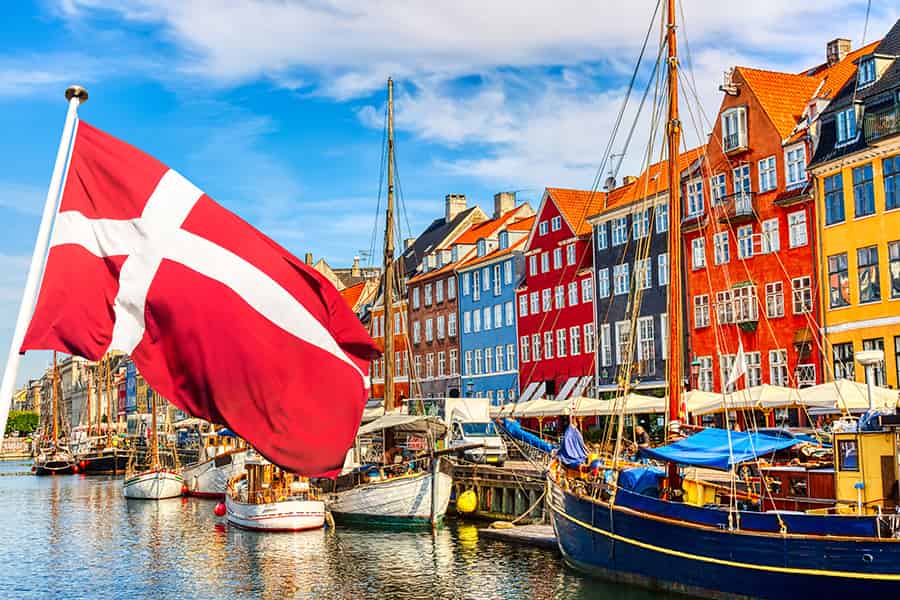- Home
- Leisure & Lifestyle
- Learning
- 6 languages that are easier for English speakers to learn
There are many benefits of learning a new language. For example, it can help to keep your brain young, boost confidence, advance your career, and connect you with different cultures. However, while most of us like the idea of being able to speak another language fluently, the learning process comes more naturally to some people than others.
Plus, with so many different languages spoken worldwide, it can be tricky to decide which one you’d like to spend your time learning. For example, should you learn a language that’s widely spoken? One that’s a little more unusual? Or perhaps a language that’ll be most useful for your next trip?
If you’re feeling stuck, why not pick a language that’s proven to be easier for English speakers to learn?
Since English is a member of the Germanic language family, many languages from the same heritage share crossovers in vocabulary, pronunciation, and grammar. Equally, learning a language that doesn’t have complex grammatical rules and unique alphabets can also be more straightforward.
Of course, any new skill worth having takes time and effort – but choosing one of these languages should make for a slightly smoother learning process.
With that said, here are six languages that are easier for English speakers to learn.
1. Norwegian

The case for learning Norwegian certainly doesn’t lie in how widely spoken it is. Norway is the only country where Norwegian is the official language and its population only reaches around five million. However, there are many reasons why Norwegian is still a great language to learn.
Norwegian comes from the same Germanic family of languages as English and, as a result, they share quite a bit of vocabulary. For example, the seasons of ‘vinter’ and ‘sommer’ don’t look too dissimilar to our own English words.
Learning Norwegian grammar is also fairly straightforward because there’s only one form of each verb per tense. And, even better, the word order in Norwegian sentences closely resembles that of English, so getting to know the sentence structure shouldn’t be too difficult. For example, ‘Can you help me?’ translates to ‘Kan du hjelpe meg?’
Plus, if accents have never been your strong suit, you’ll be pleased to hear there’s much more room for error while speaking Norwegian. Because there are so many different accents in Norway, there’s actually no absolute ‘correct’ way to pronounce the words.
Other benefits of learning Norwegian include Norway’s show-stopping tourist sites – just picture the natural wonders of glaciers, mountains, the fjords, and the Northern Lights.
And, if you’re a particular fan of literature, learning Norwegian can help to bring some of the most-loved Norwegian works to life. Even though it’s not a particularly widespread language, Norway has left a significant literary footprint. In fact, James Joyce learnt Norwegian just so that he could read the original versions of Henrik Iben’s works.
2. Dutch

Dutch is another member of the Germanic language family. It’s spoken by the majority of people in the Netherlands, as well as by a large proportion of Belgium’s population.
After German and English, Dutch is the third most spoken Germanic language, and rather fittingly, it sounds like a combination of English and German.
Perhaps one of the biggest advantages of learning Dutch is that many of the words are spelt exactly the same as they are in English – more so than in almost any other language. Yet, it’s worth bearing in mind that while spellings often match up, the words are often pronounced differently.
For example, the word ‘rat’ has the same meaning and spelling in both languages, but in Dutch it’s pronounced like ‘rot’.
Another thing to be aware of is false cognates. Cognates are words in two different languages that stem from the same ancestral language and share a similar meaning, spelling, or pronunciation. A false cognate, therefore, is where a word sounds the same as English but has a different meaning. An example of this is the word ‘wet’, which actually means ‘law’ in Dutch.
Another benefit of learning Dutch is that you essentially get two languages for the price of one. This is because the Afrikaans language was originally brought to South Africa and Namibia by the Boers (Dutch farmers). So while there are natural differences in vocabulary, switching from Dutch to Afrikaans is not too much of a jump.
3. Bahasa Indonesia

Indonesia is the fourth most populated country in the world. It’s known for its gorgeous islands (of which there are 17,508) and is thought to have at least 700 living languages. The official language recognised by the country, however, is Bahasa Indonesia.
Many Asian languages can be difficult for English speakers to learn due to their unfamiliar characters and writing systems, so you might be surprised that one has made it onto this list. But, Bahasa Indonesia is actually one of the few Asian languages that follows the Latin alphabet.
It’s also a phonetic language – meaning that the words are pronounced exactly as they’re spelt. While Indonesian grammar structures are very different to English, don’t let this put you off, because there are actually very few grammatical rules to learn.
For example, there are no verb conjunctions, no grammatical genders, and no plurals (you simply repeat the word twice). So, if grammar rules have always been your stumbling block when it comes to learning a language, Indonesian might be the answer for you.
If the thought of Indonesia as a travel destination isn’t enough to tempt you, other benefits of learning Bahasa Indonesia include grasping a better understanding of the unique Indonesian culture – as well as the fact that it’s a significant gateway to other South East Asian languages.
4. Afrikaans

Afrikaans is a West Germanic language that was previously considered a dialect of Dutch before it developed into its own language.
There are currently around 10 million native Afrikaans speakers, with the majority found in South Africa and Namibia. Though, it’s also spoken in small pockets of the UK, New Zealand, America, Kuwait, and Belgium.
As a result of its West Germanic roots, Afrikaans shares a lot of words with English, which makes it an easier language to learn and pronounce.
The grammatical structure is also much simpler and easier to get the hang of than some languages. There are no noun genders or verb conjugations, and only three tenses – so you won’t have to worry about the subjunctive, pluperfect, and imperfect tenses that are known for scaring learners away.
However, while the pronunciation and grammar might be fairly pain-free, the only downside is that Afrikaans intonations and sounds will probably take some getting used to.
The speech pattern is fairly different, and unlike English, double negatives are extremely common. For example, where in English we would say ‘He cannot speak Afrikaans’, in Afrikaans ‘Sy kan nie Afrikaans praat nie’ literally means ‘She cannot speak Afrikaans not’.
Afrikaans is also interesting because most translations are very direct. For example, the word ‘aardvark’ literally translates to ‘earth pig’ in English. As a result, many English speakers enjoy finding out how Afrikaans words translate, which makes the learning process more fun.
Plus, as mentioned earlier – due to its history of being brought over to South Africa and Namibia by the Dutch – you can essentially learn two languages for the price of one by studying Afrikaans.
5. Swedish

Swedish is a Scandinavian language and another member of the Germanic language family. It’s spoken by almost 10 million people worldwide, around 8.5 million of which live in Sweden. Even if you’ve never been to Sweden yourself, you might have come across the language during a trip to IKEA…
One of the main reasons that Swedish is one of the easiest languages for English speakers to learn is due to the number of cognates. For example, to ‘start’ is ‘starta’ in Swedish, and ‘grass’ is ‘gras’.
Getting your head around the extra Swedish vowels (å, ä, and ö) may take a little more getting used to. But, since Swedish also shares a lot of grammar, sentence structure, and vocabulary similarities with English, it shouldn’t be too tricky.
Another plus of learning Swedish (or Norwegian and Danish for that matter) is that it opens the door to learning other Scandinavian languages. There are close links between Swedish, Norwegian, and Danish – and speakers of these languages are often able to understand the others without too much difficulty.
Not to mention, Sweden is a beautiful place to travel to, boasting breathtaking lakes and enchanting forests. It’s no surprise that Sweden is consistently ranked as one of the most desirable places to live in the world.
6. Danish

There are around six million Danish speakers in the world, the majority of whom live in Denmark.
Danish is another member of the Germanic language family but it shares particular similarities with Norwegian and Swedish. And the good news is that if you have experience with one of these languages, you’ll find it much easier to learn the others.
While some aspects of Danish can be tricky to learn, this is part of what makes it quirky and unique. For example, there’s an interesting logic behind numbers in Danish, as while we count on 10s in English, 20 is the base of the counting system in Danish. This means that the number 50 – pronounced Halvtreds – literally means ‘halfway to the third 20’!
There’s also no dedicated word for ‘please’ in Danish. Instead, the culture is centered around expressing gratitude.
However, Danish still shares similar grammar rules, sentence structures, and vocabulary with English, and there’s also hundreds of cognates between the two. For example, ‘absolutely’ is ‘absolut’ in Dutch, ‘after’ is ‘efter’, and ‘half’ is ‘halv’.
Another plus is that Denmark is full of gorgeous cities, architecture, and attractions that make for great travel destinations. For example, in Copenhagen you’ll find Tivoli Palace, Copenhagen Cathedral, and Rosenborg Castle.
Denmark is also very often ranked the top place to live for quality of life, so it’s really got a lot going for it.
Final thoughts…
Being able to speak another language is an invaluable skill to have. Not only is it great for your brain, but it can also open career opportunities, improve your understanding of different cultures, and be the perfect excuse to travel.
While some people are naturally more gifted at language learning, everyone can do it. So, to get started, why not choose a language that’s easier to learn?
Selecting a language that shares the similar vocabulary, pronunciation, grammar, and Germanic heritage as English, or one that’s free of complex grammatical structures and unique alphabet characters, should help to kickstart the learning process. From Dutch and Norwegian, to Indonesian and Afrikaans, these languages will also take you all over the world.
For more inspiration, you might like to have a read of our articles; The benefits of learning a new language and 9 most spoken languages that are useful to learn. Rest Less Events also hosts various language events which you might be interested in, from British Sign Language to Spanish and French.
Have you had experience learning any of the languages above? What have you found to be the easiest languages to learn? We’d love to hear about your experiences in the comments below.
Francesca Williams is a lifestyle writer at Rest Less. She joined Rest Less in early 2021 after achieving a first-class degree in History at the University of Sheffield and qualifying as an NCTJ Gold Standard Journalist. Francesca writes across a range of lifestyle topics, specialising in health, history, and art and culture. In her spare time, Francesca likes to keep herself busy and enjoys going on walks, playing netball, going to the gym, getting involved with her local church, and socialising with friends and family.
* Links with an * by them are affiliate links which help Rest Less stay free to use as they can result in a payment or benefit to us. You can read more on how we make money here.
